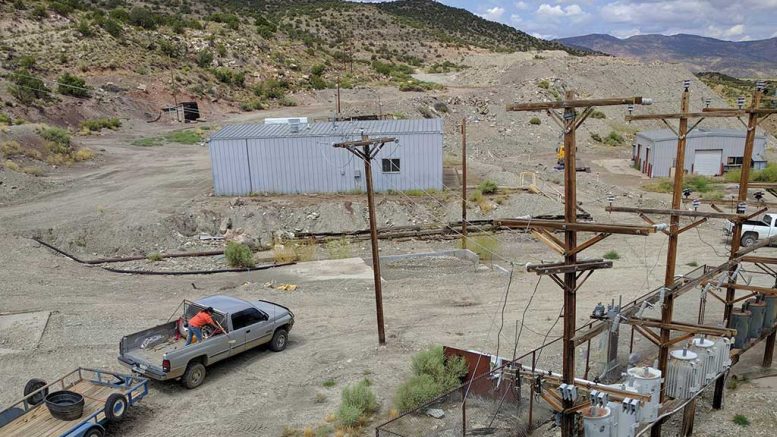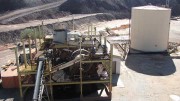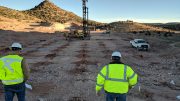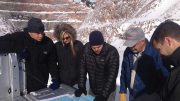Higher prices for most mined commodities has translated into renewed activity in the junior mining sector in the southwestern U.S. states. Here’s a quick look at six such companies.
CALIFORNIA GOLD MINING

Looking north along drill roads at California Gold’s Fremont gold project in California. Photo by Katie Lister.
Toronto-based junior California Gold Mining (TSXV: CGM) continues make headway advancing its wholly owned flagship Fremont high-grade gold project in central California.
The property is only 150 km east of San Francisco in relatively pro-development Mariposa County, on 14 sq. km of patented land in the prolific Mother Lode gold belt that has historically produced over 50 million oz. gold.
Total open-pit resources calculated a year ago stand at 17.2 million indicated and inferred tonnes grading 1.60 grams gold per tonne for 879,000 contained oz. gold.
The company acquired the property in 2013, and as of mid-2017 had carried out three phases of drilling totalling 15,100 metres, and preliminary metallurgical testing showing 93% recoveries from an oxide cap and 86% from sulphide zones.
Scheduled to begin in the fourth quarter of 2017 was a new round of drilling totalling 12,000 metres and further soil and geophysical surveying.
Shares last traded at 45¢, generating an $18-million market capitalization with 40.2 million shares outstanding (59.8 million fully diluted).
The company is led by president and CEO Vishal Gupta, a geologist and former mining equity analyst.
CROWN MINING
Further evidence that mining is by no means dead in California is Toronto-based junior Crown Mining (TSXV: CWM), which is exploring for copper in the state’s northeast at its historic Moonlight-Superior property, located south of Susanville in Plumas County.
The property has seen commercial production from 1915 to 1930, with more development by Placer AMEX between 1962 and 1994. Various junior operators were active at the site between 2004 and 2011, with Crown stepping into the scene in 2013.
Today, the property hosts National Instrument 43-101 compliant resources in three deposit: the Moonlight deposit has 146.5 million indicated tonnes grading 0.32% copper for 1 billion lb. copper, plus 80 million inferred tonnes at 0.28% copper for 496 million lb. copper; the Superior Mine deposit hosts 54.5 million tonnes at 0.41% copper for 487 million lb. copper; and the Engels Mine deposit hosts 2.6 million tonnes grading 1.05% copper for 60 million lb. copper.
There is also significant gold and silver present as a potential by-product credit.
Crown describes the geology as characterized by a quartz monzonite intrusive over an 18 sq. km area. Initially described as a porphyry, Crown says recent work suggests it may be an iron-ore copper-gold deposit.
Crown estimates it would require $600 million in capital costs to build a modern mine at the site.
Crown’s news flow through much of 2017 has centred around small, six-figure private placements.
NEVADA SUNRISE GOLD

Bunker at Dead Horse Hill on Nevada Sunrise Gold’s Golden Arrow gold property in Nevada. Credit: Nevada Sunrise Gold.
Vancouver-based Nevada Sunrise Gold (TSXV: NEV; US-OTC: NVSGF) is exploring for two of the hottest commodities among investors this year — gold and lithium — and is doing it in one of the world’s premier jurisdictions for mining: Nevada.
Its three gold exploration properties in the state are Golden Arrow, Kinsley Mountain and Roulette, and in the state’s southwest are its wholly owned Neptune and Aquarius lithium brine projects.
Its most advanced gold project is its 100%-owned Golden Arrow property northeast along the Walker Lane structural belt. Golden Arrow hosts a measured and indicated resource of 296,500 oz. gold and 4 million oz. silver in 12.2 million tonnes grading 0.024 oz. gold per ton (0.82 gram gold per tonne) and 0.33 oz. silver per ton (11.31 grams silver per tonne), plus 3.8 million tonnes at lower gold grades. These figures were calculated in 2009.
In July 2017, Nevada Sunrise struck an agreement with Emgold Mining (TSXV: EMR) granting Emgold the option to acquire up to an 80% interest in the project by paying US$250,000 in cash, 2 million units in Emgold and spending $2.75 million on exploration over three years.
In November Nevada Sunrise Gold and its partner Advantage Lithium (TSXV: AAL) sold their Clayton NE lithium project to Pure Energy Minerals (TSXV: PE; US-OTC: PEMIF). The Clayton NE property borders the lithium brine mine operated by Albemarle (NYSE: ALB) at Silver Peak in Nevada’s Clayton Valley.
Just before the sale, Advantage exercised its option to acquire 70% of the project, so that Nevada Sunrise wound up with 2.1 million Pure Energy shares while Advantage received 4.9 million Pure Energy shares.
On Nov. 21, Nevada Sunrise signed a letter of intent to acquire 100% of the Lovelock high-grade cobalt property, 150 km east of Reno, Nev., in return for a small series of cash and share payments over three years.
PREMIER GOLD MINES

A shovel loads a haul truck at Premier Gold Mines and Barrick Gold’s South Arturo gold mine in Nevada. Credit: Premier Gold Mines.
Ewan Downie-led Premier Gold Mines (TSX: PG; US-OTC: PIRGF) continues to grow by leaps and bounds, and now boasts operating gold mines in Nevada (South Arturo) and Mexico (Mercedes mine), and has significant advanced gold projects in both jurisdictions, as well as northwestern Ontario.
South Arturo is 60% owned by operator Barrick Gold (TSX: ABX; NYSE: ABX) and 40% by Premier, which bought its stake from Goldcorp in 2015. The open-pit mine was brought into production in 2016, with ore sent to Barrick’s roaster at its vast Goldstrike gold operations in the region.
Premier’s share of production for 2017 is estimated at 50,000 to 55,000 oz. gold at all-in sustaining costs (AISCs) of only US$450 to US$480 per oz. gold. During the first half of 2017 AISCs were only US$322 per oz., making South Arturo one of the world’s lowest-cost gold mines.
The partners are evaluating bringing more open-pit deposits on the property into production as well as heading underground below current pit operations, in a project named El Nino.
Also in Nevada, Premier has its fully owned, past-producing McCoy-Cove high-grade gold property, which could be developed into an underground mine. The company plans to carry out definition drilling from a ramp in the second half of 2018 and carry out trial mining and complete a feasibility study in 2019.
RENAISSANCE GOLD
Reno, Nevada-based Renaissance Gold (TSX: REN; US-OTC: RNSGF) describes itself as a Nevada-based, gold- and silver-focused exploration company that emerged as a spin-out from Fronteer Gold’s 2010 acquisition of AuEx Ventures and its Long Canyon gold discovery in Nevada.
Renaissance positions itself as a prospect generator that brings in joint-venture partners to shoulder the costs of more advanced exploration.
In May 2017, Renaissance acquired privately held Kinetic Gold Corp. and its subsidiaries, which hold various exploration properties located in Nevada.
Kinetic’s president and CEO Robert P. Felder then became Renaissance Gold’s president. Things went so well, Felder added CEO to his title in November, with Ronald Parratt staying on as executive chairman.
In the Great Basin region as of October, Renaissance had 11 Carlin-type projects, nine epithermal projects and two intrusive-related projects in 11 agreements, plus a few more in the works.
WESTERN URANIUM

A seam hosting 2% uranium and high-grade vanadium (the black rock) at Western Uranium’s past-producing Sunday mine in Colorado. Credit: Western Uranium.
George Glasier-led Western Uranium (CSE: WUC; US-OTC: WSTRF) is a Colorado-based uranium and vanadium conventional mining company focused on low-cost, near-term production of uranium and vanadium in the western U.S., as well as the development and application of ablation mining technology.
Western Uranium says it is the third largest in-situ holder of historic uranium resources in the U.S., with a resource of 90 million lb. uranium oxide and the second-largest holder of vanadium resources in the U.S., with 35 million lb. vanadium oxide grading between 1.4–2% vanadium oxide.
Its plan is to restart production at its permitted Sunday uranium mine complex in Colorado, and it has already secured rights to build the first uranium mill in the U.S. in 30 years.






Would NAFTA demise have any impact on exploration in US by Canadian companies?